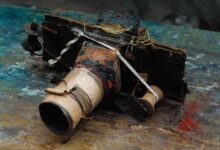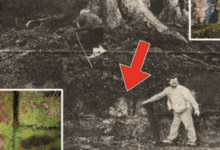The Shocking Archaeological Discoveries In The Philippines That Have Left Scientists Puzzled
The Shocking Archaeological Discoveries In The Philippines That Have Left Scientists Puzzled
Beyond its breathtaking islands and vibrant culture, the Philippines hides a treasure trove of ancient secrets waiting to be uncovered. Over the years, archaeologists have made astonishing discoveries—from mysterious burial practices to lost cities emerging from the depths. Here are 11 of the most shocking archaeological finds in the Philippines that have left scientists puzzled.
1. The Lost Town of Pantabangan Rises from the Depths
What happens when a long-dormant town, submerged for half a century, suddenly resurfaces? On May 24, 2024, after an intense heatwave, the water levels of the Pantabangan Reservoir in Nueva Ecija dropped by a staggering 26 meters, revealing the ruins of a lost town buried underwater for over 50 years.
Pantabangan, once home to 1,300 residents, was flooded in 1970 to create the reservoir, forcing people to relocate and rebury their dead on higher ground. As the ruins emerged, parts of an old church, gravestones, and building foundations came into view, drawing in curious tourists. The phenomenon turned into an unexpected economic boost for the locals, with fishermen like Nelson Delera seeing their daily earnings skyrocket from 200 pesos to as much as 8,000 pesos.
2. The Laguna Copperplate: A Thousand-Year-Old Debt Relief Document
One of the oldest written records in the Philippines, the Laguna Copperplate Inscription, was unearthed in 1987 along the Lumbang River. Dating back to April 21, 900 AD, this ancient document, inscribed in Old Malay and Kawi script, details a debt forgiveness transaction. The discovery proved the existence of a sophisticated society connected to Southeast Asian trade networks long before Spanish colonization.
3. The Fire-Preserved Mummies of Mount Pulag
Deep in the caves of Mount Pulag, a spine-chilling discovery awaited explorers—centuries-old mummified bodies, curled inside wooden coffins, eerily well-preserved. Known as “Ebola Corpses”, these remains were part of an ancient ritual where the dead were smoked over flames for weeks. The ritual ended when Spanish colonizers arrived in the 15th century, imposing their own burial traditions.
For years, looters stole and sold these mummies on the black market. Today, the caves remain a protected site, with locals guarding their location to prevent further disturbances. Some even believe the bodies belonged to deities whose curse still lingers.
4. The Ghost Ship with a Mummified Sailor
In 2016, Filipino fishermen off the southern coast of the Philippines made a terrifying discovery—a ghost ship drifting aimlessly at sea. Inside, they found the dried-out corpse of German sailor Manfred Fritz Bajorat, sitting at his radio desk as if frozen in time.
Bajorat, a seasoned explorer, had been at sea for years, mourning his late wife. His body, preserved by the salty sea air, was so intact that it appeared almost mummified. Investigators determined he died of a heart attack, but his ship’s mysterious journey remains unknown.
5. The Tattooed Mummies of Mount Timbac
In 2015, archaeologists uncovered an extraordinary burial site in the caves of Mount Timbac—bodies so well-preserved that their ancient tattoos were still visible after more than a thousand years.
The indigenous Ibaloi people practiced a unique ritual of smoking their dead for months to prevent decomposition. The bodies were then placed in tombs, hidden deep within the mountains. This practice disappeared with the arrival of Spanish colonizers, but the mummies remained untouched for centuries.
6. The Hanging Coffins of Sagada
Unlike traditional burials, the indigenous Igorot people suspended their deceased high on limestone cliffs in wooden coffins. They believed this would bring their ancestors closer to the spirits. Some of these coffins, over 2,000 years old, remain hanging today—an eerie reminder of a lost tradition.
7. The Mysterious Balangay Boats: 1,000-Year-Old Watercraft
Discovered in Butuan, the Balangay boats are ancient wooden watercraft dating back to 320 AD. These remarkably preserved vessels prove that early Filipinos were skilled navigators who traveled across Southeast Asia long before the arrival of European explorers.
8. The Unsettling Pose of the “Bohol Death Mask”
In the province of Bohol, archaeologists unearthed human remains with golden facial coverings, a practice previously unknown in Philippine history. The deceased had their faces adorned with gold death masks, suggesting connections to ancient Southeast Asian burial traditions.
9. The 700-Year-Old Rice Terraces of Banaue
Often called the “Eighth Wonder of the World,” the Banaue Rice Terraces were carved into the mountains by the Ifugao people over 700 years ago. Scientists remain baffled by how this advanced irrigation system was created without modern tools.
10. The Ancient Gold Treasures of Surigao
In 1981, miners in Surigao discovered an incredible hoard of ancient gold artifacts, including jewelry, ceremonial items, and golden sashes. The discovery proved that pre-colonial Filipinos had a thriving gold industry and intricate craftsmanship skills.
11. The Cave of Ancient Giants
Legends speak of giant human-like bones found in caves across the Philippines. While some believe they belonged to early human species, others speculate they could be linked to folklore about ancient giants who once roamed the islands.
A Land of Untold Mysteries
From submerged towns to fire-preserved mummies, the Philippines is home to some of the most astonishing archaeological discoveries in history. Each new finding reshapes our understanding of the past, proving that this island nation still has many secrets waiting to be uncovered.
As we venture deeper into this cave, we encounter a rare sight—a species of rock formation that’s becoming increasingly uncommon in this area. But we’re not stopping here. Up ahead lies the next chamber, also known as the Highest Chamber, and trust me, it’s a breathtaking spectacle. However, the adventure doesn’t end there.
Next, we step into the Third Chamber, but be warned—it’s pitch black. That’s why we call it the Dark Room. With no natural light filtering through, this section of the cave is shrouded in mystery. But once we switch on our flashlights, something extraordinary comes into view: tiny droplets of water trickling down from the stalactites, forming delicate mineral deposits that have taken centuries—if not millennia—to create. The cave is still very much alive, constantly evolving, shaping itself drop by drop.
Now, we move toward the Fourth Chamber, known as the Ice Cream Room due to its unusual formations that resemble giant scoops of ice cream. It’s a sight both bizarre and fascinating. But just when you think it can’t get any more surreal, we stumble upon the Angel Swing Rock Formation, one of the many awe-inspiring wonders hidden within this labyrinth of stone.
But hold on—there’s more!
A Jungle of Stone and Shadows
Our journey continues into the Fifth Chamber, often called the Jungle Area. Here, the rock formations take on familiar shapes—some resembling animals, others eerily mimicking human skeletal remains. One particularly striking formation looks like a lion kissing a giant turtle—a haunting yet mesmerizing scene crafted entirely by nature.
The deeper we go, the more treacherous the path becomes. The route ahead is steep, slippery, and certainly not for the faint of heart. But beyond these obstacles lies something truly astonishing.
A Frozen Mummy Locked in Time
Imagine stumbling upon a perfectly preserved mummy, frozen in ice for millions of years. That’s exactly what scientists have just discovered—an ancient human, buried deep beneath thick layers of ice, whose existence could rewrite everything we know about early human history.
Early examinations suggest that this individual may have belonged to a previously unknown group of humans, potentially pushing our timeline of human evolution back by 20 million years. Even more shocking, the mummy’s skin, hair, and even clothing remain intact, offering a rare and invaluable glimpse into the life and survival of early humans in extreme conditions.
But here’s the real game-changer: scientists are now attempting to extract DNA from the frozen remains. This could unlock groundbreaking insights into ancient genetics, health, and survival adaptations. What secrets does this mummy hold? Only time—and science—will tell.
The Hanging Coffins of Sagada: Where the Dead Watch Over the Living
From the icy grips of time, we shift to a more spiritual mystery—the hanging coffins of Sagada in the remote mountains of the Philippines. For over 400 years, the Igorot people have practiced a bizarre yet sacred burial ritual: instead of being buried underground, the deceased are placed in wooden coffins and suspended high on cliff faces or tucked away inside caves.
Why?
Because they believe that elevating the dead brings them closer to their ancestors and to heaven while keeping their spirits close to the living. This ancient tradition is a powerful symbol of unity between life and death, where the deceased continue to watch over their loved ones.
But here’s something eerie: during the funeral procession, family members pass the body hand-to-hand, and if any liquid drips from the coffin, it’s considered a blessing of good luck. The most recent burial in this sacred tradition took place in 2010, making Sagada one of the last remaining places where this ritual is still alive.
The Manunggul Jar: A Portal to the Afterlife
If the hanging coffins reveal the bond between the living and the dead, then the Manunggul Jar tells the story of what lies beyond.
Discovered in the Manunggul Cave in Palawan in 1962, this ancient burial jar dates back to 890–710 BCE and is regarded as one of the greatest masterpieces of pre-colonial Filipino art. Its lid features two human figures in a boat, believed to represent a soul being guided to the afterlife by the spirit boatman—a depiction of the Filipino belief in the journey beyond death.
Found alongside the remains of Tabon Man—one of the Philippines’ oldest known humans—this jar was used in secondary burial, meaning only the cleaned bones of the deceased were placed inside. It serves as a time capsule of ancient Filipino spirituality, maritime culture, and their deeply rooted respect for the afterlife.
Today, the Manunggul Jar is housed in the National Museum of the Philippines, drawing visitors eager to glimpse this profound artifact that links the past, present, and the mysteries of what lies beyond.
Final Thoughts
From the pitch-black depths of hidden caves to the frozen secrets of ancient humans, from hanging coffins that defy gravity to sacred burial jars that guide souls to the beyond, these discoveries remind us just how much of our world remains unexplored.
The past is alive in ways we can’t always see, waiting for those bold enough to uncover its mysteries.




